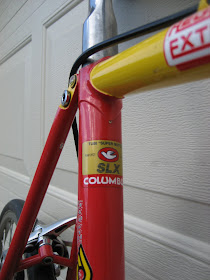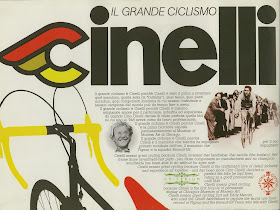
Bill & Carol McGann have been kind enough to provide us with the preface and an excerpt from their new paperback book, "The Story of the Giro d'Italia", A Year-by-Year History of the Tour of Italy, Volume One: 1909 - 1970". The book version is now available from Amazon and Barnes & Noble (.com); ISBN: 978-0984311767. The Kindle version will be available soon.
Here's the complete preface to The Story of the Giro d'Italia:While working on our history of the Tour de France, I was struck by dearth of information available in English about the second most important race in the world, the Giro d’Italia. I say second most important, but I hope after reading this history the reader may come to hold the same opinion I have, that today it is the world’s finest race. The Giro ranks above all others not because it has a superior peloton or more fans or a longer history or greater prestige or more prize money. The Tour de France easily wins on all of those counts. But this is about sports, and sports are about competition, and there the Giro wins, hands down.
First of all, the Giro takes place in Italy, blessed as almost no other place on Earth with beautiful cities, rugged mountains and people insanely passionate about sports. Here, bicycle racing matters, and matters a lot. The riders know they are competing under the hot light of fiery love of the sport.
The Giro is raced in the spring, when sudden storms can come out of nowhere. In the mountains, this means abundant sunshine can quickly turn to intolerable cold, fog, rain, snow and ice. Some of the Giro’s greatest dramas took place while Mother Nature raged at the helpless cyclists. Only eight riders finished the 1914 Giro, a testimony to that edition’s difficulty. Other years have seen mass abandonments when the majority of the racers could no longer endure the dantesque conditions the race imposed. These episodes of terrible suffering, from which great champions have forged victories, are far more common in the Giro than in the Tour. Between baking Sicilian heat, near vertical Dolomite ascents, freezing snowstorms and blinding torrents of rain, the Giro has put its riders in extremis more often than the other Grand Tours.
While it wasn’t always true, today the quality of the Giro’s racing is superior. I believe that the Tour de France’s racing is often dull and negative compared to that of the Giro. It may well be that the Tour is so important, the riders race it not to win, but to not lose. With its days of slow, piano racing mostly a thing of the past, the Giro can be a bare-knuckle brawl from start to finish. There has been no race in recent memory to rival the 2009 Giro, with its down-to-the-wire slugfest between winner Denis Menchov and Danilo Di Luca. The last time the Tour had such a fracas was probably the 1989 duel between Laurent Fignon and Greg LeMond.
Today the Giro is measurably harder to race than the Tour. With power meters attached to the riders’ bikes, we know that Giro racers go deeper and expend more energy than those competing in the Tour.
Following the footsteps of predecessor Vincenzo Torriani, current Giro boss Angelo Zomagnan creates race routes that are interesting, challenging to the riders, generally keeping the outcome in suspense until the final couple of days, leaving the sports fan excited and on the edge of his seat for three weeks.
That’s why I love the Giro d’Italia.
The great rivalry between Fausto Coppi and Gino Bartali is well known, mostly because of their adventures in the Tour de France. But for much of bike racing’s history the Alps have been a high wall, and Italian sponsors preferred to keep their racers at home where they could earn valuable publicity. Because of this, there is a whole world of great athletes who are virtually unknown to the non-Italian cycling fan. How about Giovanni Valetti? In 1939 Valetti beat Bartali when Gino was at the very peak of his powers. Has anyone heard of Giuseppe Enrici, the Giro winner who was born in Pittsburgh? Alfonsina Strada was the only woman who entered (and unofficially finished) a Grand Tour. And there was Giordano Cottur, who won a Giro stage in Trieste while guns blazed.
Clearly, this is a story that has to be told.
Here is the excerpt from the 1939 Giro d'Italia, there are a few changes to the text in the book in order to make it understandable in an excerpt.Because Gino Bartali had missed the 1938 edition where Giovanni Valetti had crushed the competition, what the tifosi wanted was a real head-to-head match-up between Italy’s two finest stage racers on their home soil. Bartali was ready and fit, having won Milan–San Remo from a six-man break that included Aldo Bini and Mario Vicini. Valetti’s impact on the races of the time is much lighter than Bartali’s but we do know from the ferocity of the racing in the 1939 Giro that Valetti came to Milan on April 28 in truly sparkling form.
There was perhaps one other rider entered who was close to the level of Bartali and Valetti that year, Vicini. But the rest, Bergamaschi, Canavesi, Del Cancia, Di Paco and Cino Cinelli (the same Cinelli who went on to bicycle industry fame), to name a few, were merely excellent professional riders. Valetti and Bartali were extraordinary, the likes of whom turn otherwise superb riders into also-rans and mentions in Giro histories.
The nineteen-stage, 3,006-kilometer schedule took the riders no further south than Rome. It was really a Giro d’(Northern) Italia.
1935 winner Vasco Bergamaschi took the first stage win in Turin but the second stage into Genoa had the race’s first real ordering of the General Classification. When Bartali, Cinelli and Vicini finished in Genoa in that order, they were a minute ahead of the next rider, Del Cancia, and a full five and a half minutes ahead of the main peloton containing Valetti.
Gino Bartali was in pink.
The next day Bartali missed the break—part of his pattern of regularly being on the wrong side of peloton fractures—and finished seven minutes behind the ten-man winning group that just happened to contain Valetti. The only Legnano (Bartali’s team) rider in the escape was Secondo Magni. The break contained riders from Frejus, Bianchi, Lygie, Ganna, Gloria, La Voce di Mantova and Il Littoriale. All the major teams except Olympia and the Belgians had at least one of their men in the break. It was a perfect assembly of riders, several of whom were team leaders, to wreak maximum destruction on the hopes of the 25-year-old Bartali.
Cinelli was now the leader with Vicini in second place at the same time. Valetti was eighth, 5 minutes 33 seconds behind and Bartali was ninth, at 7 minutes 2 seconds.
Stage six, a short 85-kilometer half stage before the afternoon’s time trial, had a surprising finish. Carmine Saponetti, an independent rider placed in the “Voce di Mantova” group, won the stage from a three-man break, aided by Bianchi team leader Adolfo Leoni who had let himself come in second.
Why did the Bianchi captain gift the stage win to Saponetti? Saponetti was broke. He started the Giro with 40 lire in his pocket and hoped to earn a little cash as the race progressed. His mother was so concerned that she came to his hotel room in Rome where the fifth stage ended with 100 lire for the impoverished, unsponsored Saponetti. The generous Leoni let the poor farmer’s son pocket some desperately needed money by letting him triumph at the finish in Rieti.
Except for Vicini’s loss of three minutes in stage five, the standings hadn’t changed before the stage seven timed hill-climb to Terminillo. Valetti won it, besting Bartali by 28 seconds and Cinelli by more than 2 minutes.
That gave the following General Classification:
1. Cino Cinelli
2. Secondo Magni @ 1 minute 28 seconds
3. Settimo Simonini @ 3 minutes 27 seconds
4. Giovanni Valetti @ 3 minutes 29 seconds
5. Mario Vicini @ 4 minutes
8. Gino Bartali @ 5 minutes 19 seconds
The race headed north, up the Adriatic coast with a detour deep into Bartali’s Tuscany. Cinelli lost enough time because of a collision with a motorcycle in stage ten to lose the lead. Stage eleven took the riders on a trip over the Apennines with an ascent of the Passo del Muraglione. Bartali was first across the line in Florence with Cinelli second and Valetti still further back, but with the same time. Valetti took over the maglia rosa as the race got a bit tighter.
The General Classification now stood thus:
1. Giovanni Valetti
2. Cino Cinelli @ 11 seconds
3. Mario Vicini @ 31 seconds
4. Adolfo Leoni @ 1 minute 26 seconds
5. Severino Canavesi @ 1 minute 39 seconds
6. Gino Bartali @ 1 minute 50 seconds
The year’s second time trial (counting the Terminillo hill climb) was held in Trieste. Valetti proved he deserved the leadership by beating all in the 42-kilometer test. Vicini lost 1 minute 46 seconds and Bartali gave up over two minutes. Valetti now held a lead over Bartali that was a single second short of four minutes.
Stage sixteen signaled the Giro’s arrival in the Dolomites with a scaling of the Passo della Mauria before the finish down the valley in Cortina d’Ampezzo. Bartali couldn’t drop the Piedmontese rider and once again they finished with the same time.
Stage seventeen was 258 kilometers going from Cortina d’Ampezzo to Trent with the Passo Rolle the principle obstacle. Bartali knew he was running out of race. He was first over the Rolle and, after joining up with Vicini and several other riders, had finally managed to drop the seemingly tireless Valetti. Valetti was put into crisis by Bartali’s attack, relinquishing 7 minutes 48 seconds. Gino Bartali was the new leader with Vicini second at 58 seconds. The race seemed hopelessly lost to Valetti, fourth at 3 minutes 49 seconds with only two stages to go.
The Italian cycling world was insane with excitement over the duel between these two riders with most experts considering the race a done deal at this point. The two-time Giro and 1938 Tour winner was riding in a commanding fashion with a lead that should allow him to arrive in Milan in pink.
But this was a battle between two great champions and neither one was going to give up. The penultimate day was the last one in the high mountains. It was a 166-kilometer race from Trent to Sondrio with the Tonale and Aprica passes providing Valetti a last chance to salvage his Giro. Reports of exactly what happened that day differ widely, but here’s my understanding of the stage.
Valetti attacked early, but Bartali was able to bridge up to him, bringing along Valetti’s teammate Olimpio Bizzi. Valetti then flatted and Bizzi gave Valetti his wheel, but Bartali hadn’t waited around, he was gone.
Bartali was able to get over the Tonale first, a good five minutes ahead of Valetti but it did him no good. Bizzi had rejoined Valetti and the two of them left Bartali behind when he flatted. Valetti made good his escape at Aprica, winning the stage in terrible, freezing weather (the Tonale pass had 20 centimeters of snow). To paraphrase American racer Floyd Landis, Bartali chose a bad day to have a bad day. While Valetti was working with a will to perform a miracle, a desperate Bartali flatted yet again and then crashed. Worse for him, his team car was delayed and slow to get him a new wheel. Valetti came into the finish in Sondrio over five minutes ahead of the first chaser (teammate Bizzi) and almost seven minutes ahead of Bartali and Vicini.
But there’s more to this day than just some hard racing and rotten luck. The Frejus (Valetti’s team) car was ahead of Bartali’s Legnano team service car on the road. To prevent the Legnano car from moving up to help Bartali, the Frejus driver pretended to lose control in the snow, ending up stopped with his car sideways in the middle of the road. The Legnano car was blocked while Bartali was trying to change a sew-up tire in the freezing weather. Valetti then flatted, and when the mechanic arrived, he purposely wrecked Valetti’s wheel so that he could show the judges that the wheel needed a replacement rather than a time consuming tire change.
Valetti was back in pink with Bartali almost three minutes behind in second place.
Bartali escaped on the Ghisallo climb in the final run-in to Milan but Valetti and the rest of the field weren’t letting him get away. The pack pulled him back, but the relentless Bartali still won the final stage. Small consolation for second place overall.
Historian Leo Turrini has written that there might have been something a bit hinky about the 1939 Giro. Valetti was a member of the Young Fascists but Bartali had declined to join them. He was instead, a member of Catholic Action, a lay organization that had an uneasy, competitive relationship with the government. Was there something strange about that day in the snow that cost Bartali so dearly or was it just bad luck meeting an on-form Valetti? Turrini writes that Mussolini’s domestic espionage agency OVRA left a document that leads one to believe there might have been some sort of government involvement in that snowy stage eighteen. Seventy years later, everyone involved is dead. We’ll probably never know.
Now both men had two Giro victories, but Valetti never did anything great in cycling again. One writer called him a bright meteor that blazed briefly across the cycling sky. It’s an admirable legacy, two Giri and a Tour of Switzerland. Valetti tried to come back after the war, but his time had passed.
Final 1939 Giro d’Italia General Classification:
1. Giovanni Valetti (Frejus) 86 hours 2 minutes
2. Gino Bartali (Legnano) @ 2 minutes 59 seconds
3. Mario Vicini (Lygie) @ 5 minutes 7 seconds
4. Severino Canavesi (Gloria) @ 7 minutes 55 seconds
5. Settimo Simonini (Il Littoriale) @ 16 minutes 40 seconds
Climbers’ Competition:
1. Gino Bartali (Legnano)
2. Giovanni Valetti (Frejus)
3. Michele Benente (Olympia)
On June 4, a couple of weeks after the Giro concluded, 20-year-old Fausto Coppi, in the words of Philippe Brunel, “arrived on the scene and scrambled Bartali’s orderly life” by breaking away from the pack in the Tour of Piedmont. He was caught after his chain began slipping and finished third behind the day’s winner, Bartali. That evening Legnano team boss Pavesi signed Coppi to be a gregario for Bartali.
I invite you to contribute by sending in photographs of your Cinelli bike, illustrations, personal stories, and articles about Cinelli bikes and components.
Thanks for stopping by.
I can be contacted at veronaman@gmail.com
































